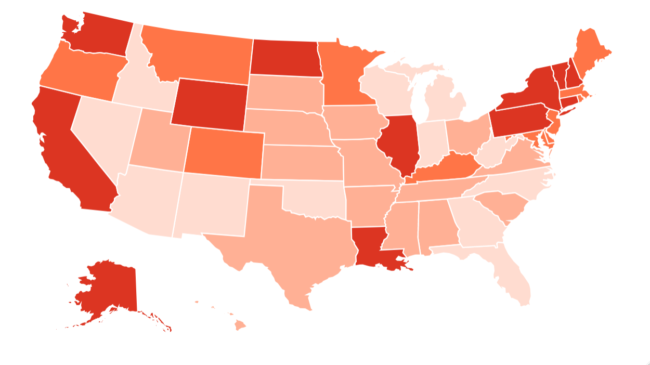Introduction
Reason Foundation’s K-12 Education Spending Spotlight includes both real and nominal U.S. Census Bureau data for all 50 states dating back to 2002, which is the starting point for continuous state-level summary figures. Data from FY 2019 is the most recent school finance data available at this time. Users of this tool can explore revenue and expenditure data in categories such as spending on instruction, support services, benefits, and capital outlays. In this overview, we provide a snapshot of important national trends in education spending, but Reason’s full K-12 Education Spending Spotlight with state-level data can be found here and a mobile version is available here.
K-12 Education Revenue Growth
Nationwide, inflation-adjusted K-12 revenues grew by nearly 24%—or $3,005 per pupil—between 2002 and 2019. During this time, per-pupil revenues increased in all but two states and 23 states plus D.C. increased their education funding by at least 20%. Notably, education spending grew by nearly 68% in New York and more than 50% in New Hampshire and North Dakota. Figure 1 and Table 2 below show the rates at which states have increased their education spending since 2002.
Figure 1: Changes In Per Pupil Revenue from 2002 to 2019
Table 1: Changes in Per Pupil Revenue from 2002 to 2019 by State
| State | 2019 Per Pupil Revenue | % Increase In Per Pupil Revenue Since 2002 |
| New York | $ 29,840 | 67.90% |
| North Dakota | $ 16,428 | 51.83% |
| New Hampshire | $ 19,283 | 51.39% |
| Pennsylvania | $ 21,206 | 49.23% |
| Washington | $ 17,245 | 48.75% |
| Illinois | $ 18,997 | 47.84% |
| Connecticut | $ 24,662 | 46.01% |
| Vermont | $ 22,424 | 43.49% |
| California | $ 16,872 | 37.43% |
| Louisiana | $ 13,728 | 33.94% |
| Alaska | $ 19,528 | 32.62% |
| District of Columbia | $ 31,109 | 31.62% |
| Wyoming | $ 19,152 | 30.55% |
| Rhode Island | $ 19,169 | 29.88% |
| Maryland | $ 17,925 | 28.82% |
| Kentucky | $ 12,844 | 27.99% |
| Maine | $ 16,963 | 27.45% |
| Massachusetts | $ 20,917 | 26.82% |
| New Jersey | $ 23,621 | 26.50% |
| Delaware | $ 18,529 | 26.36% |
| Montana | $ 13,744 | 26.34% |
| Oregon | $ 15,271 | 24.84% |
| Minnesota | $ 16,326 | 23.57% |
| Colorado | $ 13,749 | 23.36% |
| Kansas | $ 13,815 | 19.77% |
| Iowa | $ 14,116 | 19.33% |
| Mississippi | $ 10,380 | 18.77% |
| Hawaii | $ 17,237 | 18.43% |
| Arkansas | $ 11,735 | 18.24% |
| Tennessee | $ 10,746 | 17.79% |
| South Dakota | $ 12,203 | 17.69% |
| South Carolina | $ 13,925 | 17.50% |
| Nebraska | $ 14,266 | 15.52% |
| Utah | $ 9,755 | 15.13% |
| Missouri | $ 13,262 | 15.12% |
| Virginia | $ 13,657 | 14.38% |
| Texas | $ 12,881 | 14.05% |
| Alabama | $ 11,400 | 13.62% |
| Ohio | $ 15,539 | 12.69% |
| New Mexico | $ 12,384 | 9.99% |
| Nevada | $ 11,230 | 8.94% |
| West Virginia | $ 13,213 | 8.68% |
| Michigan | $ 15,320 | 7.19% |
| Oklahoma | $ 10,629 | 6.47% |
| Florida | $ 11,204 | 6.30% |
| Wisconsin | $ 14,582 | 5.12% |
| Georgia | $ 12,931 | 2.60% |
| Indiana | $ 13,110 | 1.54% |
| Arizona | $ 10,314 | 1.20% |
| North Carolina | $ 10,553 | -0.79% |
| Idaho | $ 9,294 | -0.81% |
While all education revenue sources—federal, state, and local—grew in per-pupil terms, local dollars increased its share of overall funding going from 42.8% to 45.6% nationally. However, in 2019, state dollars still accounted for the largest slice of the K-12 funding pie at 46.7%. This breakdown is expected to change when more recent data become available due to the federal stimulus dollars sent to states during the COVID-19 pandemic. Figure 2 displays how education funding sources have changed over time.
Figure 2: Per Pupil Revenue Sources
How Are Education Dollars Spent?
The U.S. Census Bureau reports several categories of education expenditures, but the two largest are spending on elementary-secondary programs and capital outlays. In total, more than 87% of education dollars are spent on elementary-secondary programs. Sub-categories of instruction (60%) and support services (35%) account for the bulk of elementary-secondary programs’ spending. Capital outlay is the next largest spending category, accounting for 10% of funds. The flow chart below visualizes how education expenditures are categorized.
Figure 3: K-12 Expenditures
Spending on Instruction and Support Services
Overall, spending on instruction and support services experienced similar growth rates per pupil at 19% and 24%, respectively. Between 2002 and 2019, instruction expenditures increased from $6,712 per pupil to $7,963 per pupil, but salaries only accounted for about $153 of this per-pupil amount while benefits soared by $949 per pupil—a 76% increase.
A similar trend is observed with support services expenditures as per-pupil spending on salaries grew modestly with a comparatively large spike in benefits of nearly 80%. The full K-12 Education Spending Spotlight allows users to see how spending on instruction and support services has changed in their state between 2002 and 2019.
Figure 4: Instructional Spending
Figure 5: Support Services Spending
A Closer Look at Support Services
Importantly, the support services category covers a wide range of expenditures. To get a better understanding of how these categories further break down, see the financial accounting manual published by the National Center for Education Statistics. Note that spending increases between 2002 and 2019 weren’t disproportionately absorbed by school or general administration, which grew from $619 to $738 per pupil and $220 to $257 per pupil, respectively.
The biggest increase in support services came from growth in pupil support services, which increased from $557 per pupil to $818 per pupil. This category includes non-instructional items such as psychological, guidance, and healthcare-related expenditures. It also includes paraprofessional services offered to students with disabilities such as speech pathology and occupational therapy. A breakdown of support service spending for every state is available here.
Also note that the biggest single cost under this group is operation and maintenance, which accounted for 25.6% of all support services in 2019. This includes items like building repairs, security, and groundskeeping.
Figure 6: Breakdown of Support Service Expenditures Per Pupil
More on Instructional Benefits
A substantial cost-driver for K-12 education is spending on benefits, a Census expenditure category that includes teacher pensions, health care insurance, retiree health care insurance, and other expenses. Disaggregated figures aren’t available, but research suggests that teacher pension costs are responsible for a substantial share of the observed growth in benefit expenditures. Inflation-adjusted instructional benefits—a category that doesn’t even include all school district and school staff—rose dramatically between 2002 and 2019. A total of 12 states saw real per-pupil spending increases on benefits expenditures in excess of 100%, with Hawaii, Pennsylvania, and Illinois all exceeding 170%. Only three states—Indiana, Idaho, and Wisconsin—had growth below 10%.
Table 2: Instructional Benefit Spending by State
| State | 2019 Benefit Spending | % Increase in Benefit Spending Since 2002 |
| Hawaii | $ 3,009 | 234.14% |
| Pennsylvania | $ 3,772 | 177.71% |
| Illinois | $ 3,622 | 174.76% |
| New York | $ 5,623 | 147.15% |
| New Jersey | $ 3,934 | 145.03% |
| Connecticut | $ 4,105 | 132.57% |
| New Hampshire | $ 3,207 | 131.22% |
| California | $ 2,546 | 116.52% |
| Alaska | $ 3,194 | 113.34% |
| Kentucky | $ 2,202 | 108.03% |
| Washington | $ 2,075 | 106.06% |
| Vermont | $ 3,453 | 102.10% |
| North Dakota | $ 2,162 | 88.51% |
| Louisiana | $ 2,025 | 85.20% |
| Delaware | $ 3,409 | 83.90% |
| North Carolina | $ 1,524 | 76.61% |
| Massachusetts | $ 3,277 | 75.36% |
| Virginia | $ 2,116 | 74.08% |
| Colorado | $ 1,330 | 73.04% |
| Maryland | $ 2,744 | 71.91% |
| Wyoming | $ 2,726 | 69.48% |
| Rhode Island | $ 3,031 | 65.88% |
| Arizona | $ 1,022 | 62.42% |
| Kansas | $ 1,360 | 61.66% |
| Michigan | $ 2,716 | 61.41% |
| Tennessee | $ 1,356 | 60.00% |
| Nebraska | $ 1,996 | 56.81% |
| District of Columbia | $ 1,876 | 55.74% |
| Minnesota | $ 2,016 | 52.53% |
| Missouri | $ 1,375 | 46.53% |
| Oklahoma | $ 1,168 | 43.55% |
| Ohio | $ 1,908 | 42.98% |
| Oregon | $ 2,364 | 42.55% |
| Mississippi | $ 1,187 | 39.04% |
| Iowa | $ 1,678 | 38.83% |
| New Mexico | $ 1,361 | 38.85% |
| Nevada | $ 1,468 | 37.92% |
| South Carolina | $ 1,619 | 37.41% |
| Alabama | $ 1,395 | 35.98% |
| Utah | $ 1,420 | 35.50% |
| Georgia | $ 1,909 | 32.72% |
| Arkansas | $ 1,101 | 30.91% |
| Montana | $ 1,456 | 30.75% |
| South Dakota | $ 1,183 | 28.30% |
| Maine | $ 2,388 | 27.00% |
| Texas | $ 764 | 17.49% |
| Florida | $ 1,030 | 15.35% |
| West Virginia | $ 2,108 | 11.46% |
| Indiana | $ 1,996 | 8.70% |
| Idaho | $ 1,145 | 5.40% |
| Wisconsin | $ 2,039 | 2.67% |
Conclusion
Reason Foundation’s K-12 Education Spending Spotlight can help state policymakers and other stakeholders make informed policy decisions that best serve students. The full Spending Spotlight with data for all 50 states is available here. The following columns in our K-12 Spending Spotlight series explore these trends and statistics in more depth:




